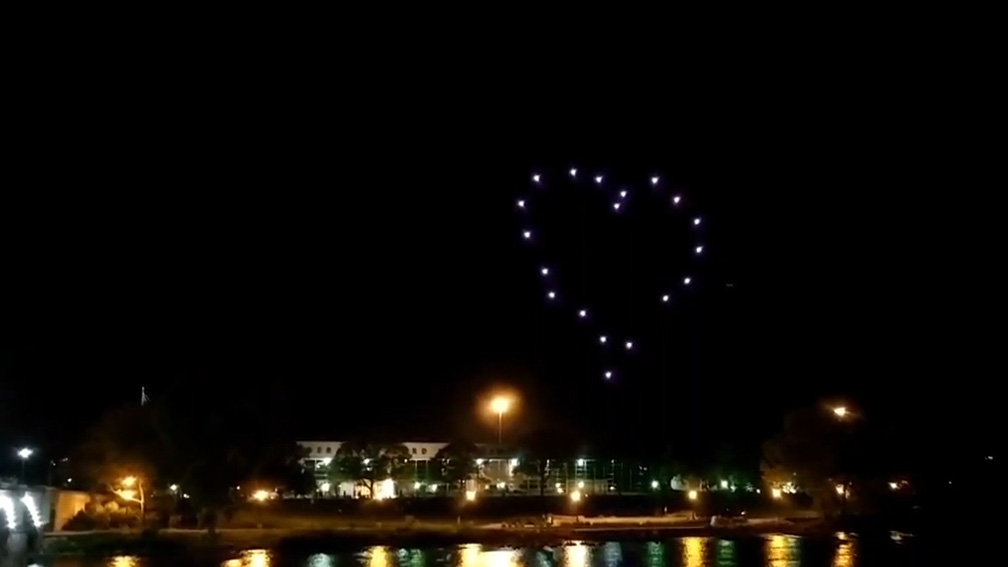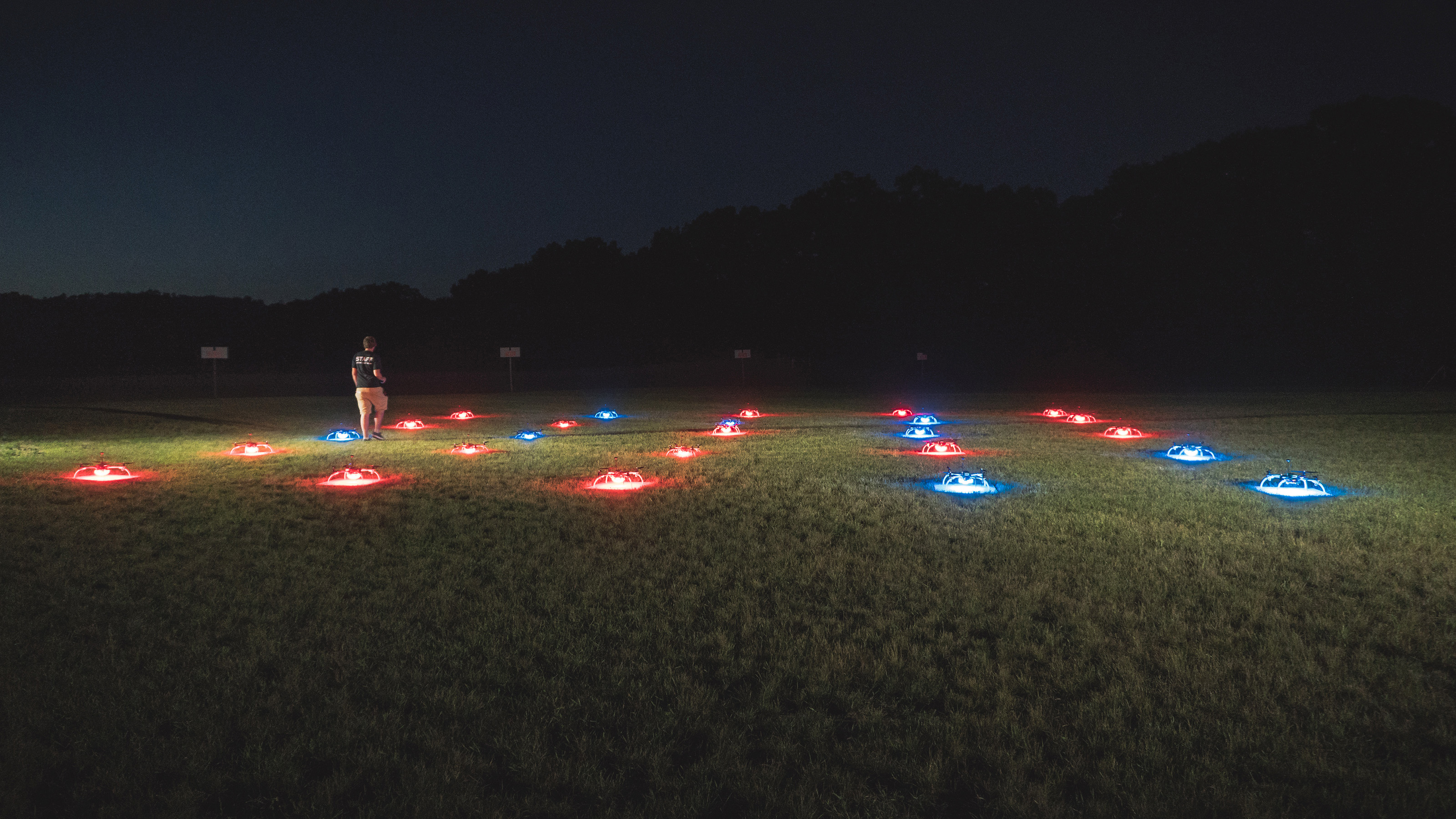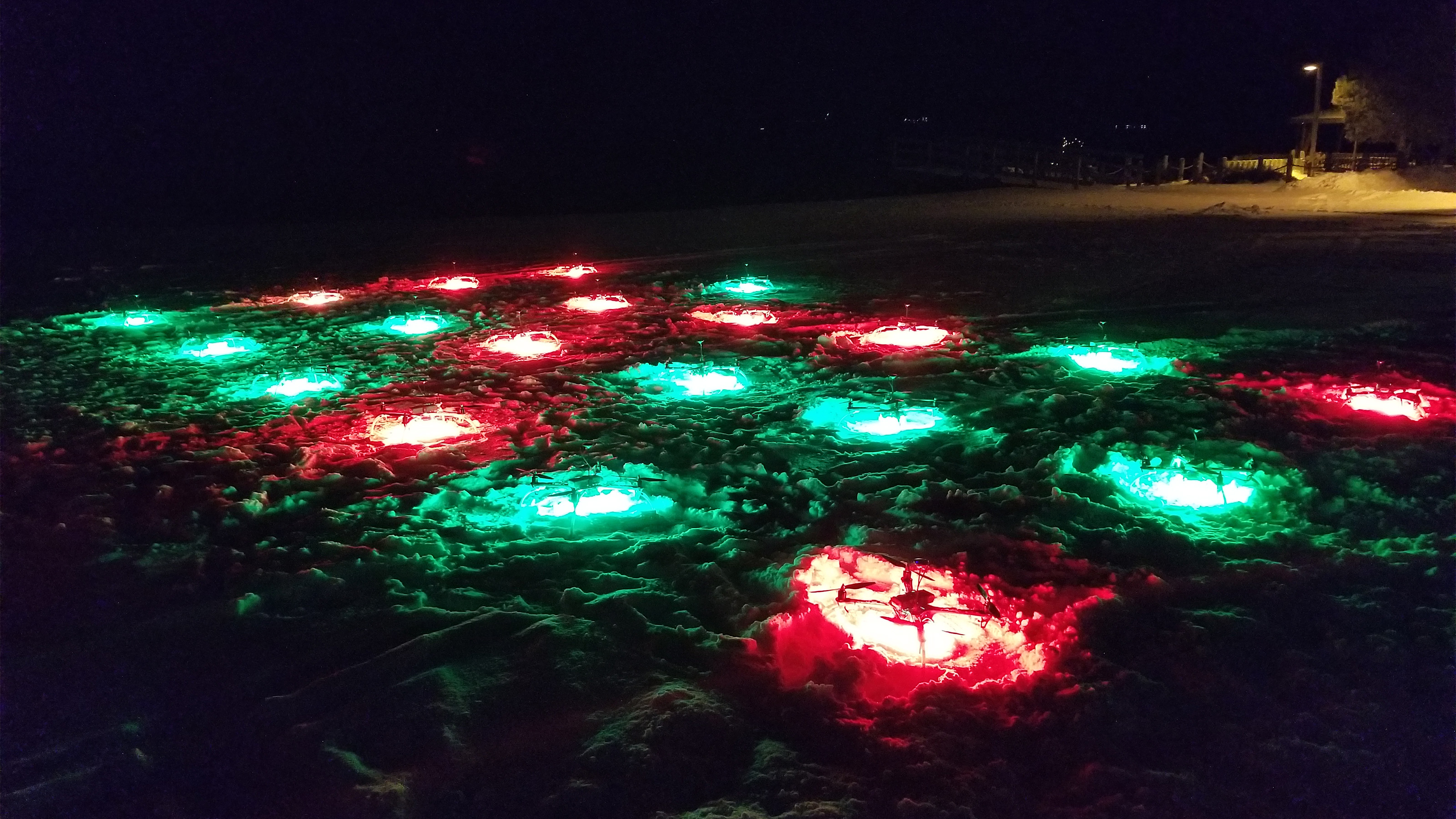Inside the AirVenture drone show
Michigan company entertains, integrates
Airplanes, fireworks, and drones will take turns in the night sky at EAA AirVenture in Oshkosh, Wisconsin, a carefully choreographed display that brings new technology to crowd-pleasing aerial entertainment for the first time.
The Great Lakes Drone Company has been working with the Experimental Aircraft Association since December to create this brand-new twist on the popular night airshow, adding unmanned aircraft to the mix for the first time. An FAA waiver granted to the Michigan firm in 2017 was the third of its kind, according to Great Lakes Drone Company Director of Operations Matt Quinn, who detailed what goes into creating the nighttime spectacle in a phone interview. (The first two waivers went to Intel, known for drone shows at the Super Bowl and Olympic Games, and The Walt Disney Co., which runs drone shows in company parks.)
“You don’t have a swarm of bats, or birds … flying into your show” when launching fireworks, Quinn noted. “I speak of that from experience.”
The former Civil Air Patrol cadet who later worked as a helicopter paramedic leads a team that includes several certificated pilots of manned as well as unmanned aircraft. Quinn said that the company agreed to produce its part of the night airshows for a minimal fee, covering only the travel expenses for a team of 12 toting up to 100 custom drones to Oshkosh.
“We’re donating the show to EAA to show that drones and the aeronautical community can get along just fine,” Quinn said. “It just takes coordination.”
Smooth integration
Intel claimed a new Guinness World Record with the first in a series of drone light shows at the company’s Folsom, California, campus on July 15, and posted a YouTube video on July 18 to commemorate flying 2,018 drones to celebrate the company’s fiftieth anniversary. That was one of several California drone shows the microchip maker had planned during the week.
FAA officials briefed AOPA staff and other interested parties July 11 about Intel’s plan to fly hundreds of drones (1,500, according to briefing documents, though it is possible Intel later increased the number to match the Folsom display) much closer to an airport—about 1.5 nautical miles from the departure end of Runway 30 (left and right) at Norman Y. Mineta San Jose International Airport, to be exact.
Intel scheduled a series of night displays in the days leading up to, on, and after the July 18 anniversary of the company’s founding. The FAA expected no impact on San Jose's Runway 30 (left and right) arrivals during the shows, while departures would be held from four minutes prior to the show until the last drone lands, about 12 minutes in all. Likewise, arrivals would be held for about 15 minutes if Runway 12 (left and right) is active at the time. Those runways typically handle about two departures and five arrivals during that period.
FAA staff told AOPA July 19 that the Intel drone shows in San Jose to date had been conducted without trouble, and minimal disruption to air traffic.

While the Intel shows are far larger, at least in terms of aircraft, than what Great Lakes Drone Company has planned for the AirVenture audience, Quinn said that doesn’t necessarily mean viewers in Oshkosh will be any less dazzled.
For one thing, the custom rigs Quinn and his team built have brighter lights (about 7,000 lumens each), and the aircraft are a bit bigger than Intel’s Shooting Star drones. A larger quadcopter can carry more weight, and “we developed a custom LED board that we attach to the drones,” Quinn said, adding that his drones can also tolerate a bit more wind, up to 19 mph rather than the 13 mph limit that can ground an Intel show.
“I don’t even really view Intel as a competitor,” Quinn said, noting that an Intel show has been reported to cost customers about $250,000 on the low end, increasing rapidly from there, while his company has a stock 25-drone show in its repertoire that costs $5,000, excluding travel expenses. “It doesn’t really matter (how many drones are used) … you can still create a very dynamic and intriguing show. It really just comes down to your show design.”
Adding complexity increases the cost sharply, up to $70,000 or more for a 100-drone show, Quinn said, though cost is not necessarily directly related to the number of drones in the air. Creating animations, such as those planned for the AirVenture spectacle, requires a great deal more work on the programming side to craft the complex choreography that is uploaded to each drone and ground controller before flight (for redundancy). Quinn said engineers spend many hours on that task, and the final testing of the AirVenture program was underway as he spoke to AOPA on July 18.
“It’s one thing to create an eagle,” Quinn said, and “another thing to make the wings flap.”
That was, in fact, a hint at what the audience will see when the drones takes to the sky over Wittman Regional Airport. Quinn said the company started with its stock “history of flight” show, and amped up the program with more than a few custom additions. Expect to see an EAA logo at some point, and the show, set to music, will finish with a patriotic flourish.
“We’re hoping that our sincere, patriotic ending with the music … will really get people pumped up,” Quinn said, noting that the AirVenture show will be the third public performance by the company, which has also completed more than three dozen private shows for corporations and other private clients. “We’re doing a couple of things (at AirVenture) that we’ve never shown anybody before.”
Safety first
Quinn said the center of the airshow viewing area will be the prime spot to view the drone formation, though engineers have done their best to make the perspective beautiful from anywhere in the audience. Early birds will catch a glimpse (weather permitting) of what’s in store when the team conducts a hover test of the drone formation on July 23.
“I think my staff loves the hover testing the most because that’s one of the few times that the staff is actually mixed in with the drones,” Quinn said. “They love that.”

Aside from company staff, nobody will be allowed to get anywhere near the drones or control station during flight operations, one of many precautions taken to ensure safety. The company worked closely with the FAA and EAA to ensure that no drone would come close to aircraft or people. Quinn said that each drone is programmed before flight with a “soft fence” and a “hard fence,” virtual barriers based on GPS position that keep the drones within a strictly defined (and tight) box. If a drone flies off course and reaches the “soft fence,” it will automatically land in place, Quinn said, while reaching the “hard fence” will prompt the motors to shut down for a less delicate landing.
“We don’t want any fly-offs. That’s why we have all these redundant safety features built into it,” Quinn said.
A dozen pairs of eyes watching from the ground will keep track of the drones, as well as watch out for any approaching aircraft. Quinn said it is standard procedure to bring the drones down immediately if a manned aircraft, such as a tourist helicopter, approaches any show in progress.
“I’m going to protect the helicopter that has people in it,” Quinn said.
Careful timing is another aspect of the safety protocol. A single computer integrated with the ground control systems keeps all of the drones synchronized, and the drone show will be coordinated with the rest of the night airshow acts, as well as the fireworks, to prevent conflicts. Each of the custom aircraft Great Lakes has built also has a custom procedure built in for a lost link with the ground station. Quinn noted that unlike most drone operations, return-to-home is not the safest course of action to program in case of a lost control link: “It’s going to fly through the path of all of these other drones trying to get back to home.”
Growing interest
The AirVenture show might have been the fourth public display by Great Lakes Drone Company staff, but for weather. The firm was hired to produce a Fourth of July show in Aspen, Colorado, one of several communities faced with elevated wildfire danger that made traditional fireworks a bad idea this year; drone shows a more appealing alternative. Ironically, it was a wildfire that wound up grounding the drones, Quinn said. That wildfire erupted 10 miles away in the days leading up to the planned show, creating a difficult wind situation.
“We were actually getting unstable and unpredictable downbursts of wind in our show area,” Quinn said. That further complicated a high-density-altitude situation that had prompted the team to fit the drones with special propellers designed for high-altitude operations.

“We were running a density altitude of 12,000 feet,” Quinn recalled of the Colorado location. Adding unstable winds to the equation pushed the risk too far, and the show was called off because Quinn and his team could not guarantee that a malfunctioning drone would remain within the show box and land (or crash) if necessary within a designated area where drones are to be crashed deliberately in case of trouble. (Quinn calls this a “safety fallout zone,” while other unmanned aircraft operators call it a “salvo area,” or use similar terms.)
Quinn said that if winds are more predictable, or calm (ideally), the tight controls built in throughout the system mean “we know exactly the area in which one of those drones is going to come down in” if a problem develops.
Quinn said there will also be such a designated area for crashing malfunctioning drones at Wittman Regional Airport, well away from aircraft and people. Quinn noted that while the company has never seen a lithium polymer battery catch fire in more than two years of operations, it does remain a possibility if this type of battery is damaged. That was the primary reason that the Aspen show was called off.
“We take our safety aspects very, very seriously,” Quinn said. “A lot of drone operators don’t even think about things like that.”
‘We’re all innovators’
The Great Lakes Drone Company is already working on a new generation of show drones, Quinn said. The current models are built on a DJI Flame Wheel 450 chassis, fitted with PixHawk flight controllers running custom firmware and software, much of it licensed from the Canadian firm Arrowonics, which continues to collaborate with the Michigan firm.
Quinn said the software and hardware are both being redesigned to create larger displays, with smaller drones that are easier to transport to show locations around the country.
Future shows may be more impressive, but anyone who has never seen a drone light show is in for a real treat, Quinn said. The same awe factor that prompted various cities to turn to drones this year will only increase, along with safety and practicality. Operators like Quinn and his team are also discovering new tricks along the way, figuring out how to dial things up another notch with each show.
“There’s no cookbook, no manual,” Quinn said. “We’re all innovators, and there’s very few of us out there doing this. We’re all learning for each other.”
It remains to be seen if drone light shows will replace traditional fireworks, or complement them, or a mix of both. Quinn said a private show conducted by the company over Niagara Falls included a coordinated fireworks and ground-lighting display that was truly dazzling. Radio-frequency identification (RFID) technology used to illuminate bracelets worn by concert attendees may also allow crowd participation in future shows.
Dave Chaimson, EAA vice president of marketing and business development, noted in a recent press release that the AirVenture display will mark another “pioneering” moment for the long-running event, the first time in North America that a drone light show has been incorporated into a night airshow.
“People come to AirVenture to see aerial excitement not seen anywhere else, and these performances certainly continue that tradition,” Chaimson said.




